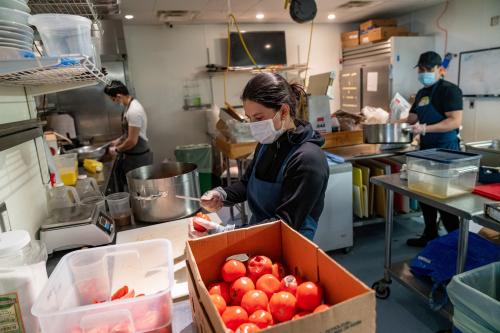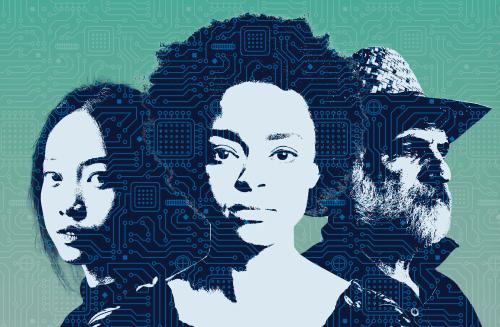As the United States reels from the COVID-19 pandemic’s catastrophic economic damage, the tight labor markets from early 2020 seem like a distant memory. The country had 11.5 million fewer jobs this August than in February, but, paradoxically, many business leaders continue to center the problem with labor markets on “unqualified” individuals without the right skills. “The COVID-19 economic shock has made the skills gap broader and the need to close it more urgent,” the World Economic Forum recently said.
This narrative frames labor market problems through a deficit lens: Low-income and displaced workers “lack” skills and motivation, contributing to the national skills gap. To solve it, the thinking goes, an individual can simply learn some skills (usually narrowly defined to mean technical skills or a short-term credential), then go into the market and get a job—or “find something new,” in the parlance of the Trump administration. But this formula—a motivated person plus skills equals success—assumes that we exist in a neutral, level market that affords all people equal opportunity.
It is time to abandon the skills gap narrative. It treats labor markets as transactional and assumes hiring processes are objective with regard to how employers recruit, sort, and assess the value of candidates. It ignores social dynamics such as race, class, age, and gender bias in the hiring process. Due to racial segregation and stunted access to professional networks, many talented Black, Latino or Hispanic, and Indigenous workers never get a real opportunity to compete for key jobs in the emerging economy.
Instead of focusing on the skills gap, we argue that it’s time to focus on closing the opportunity gap—not only for the benefit of individuals who have been shut out of the labor market, but for society as a whole. Cultivating and investing in diverse talent can unleash regional innovation, economic growth, and community well-being.
Instead of focusing on the skills gap, we argue that it’s time to focus on closing the opportunity gap—not only for the benefit of individuals who have been shut out of the labor market, but for society as a whole. Cultivating and investing in diverse talent can unleash regional innovation, economic growth, and community well-being. Investing more equally in our “lost Einsteins,” scholars have estimated, would likely quadruple the rate of innovation in the U.S.
Focusing on skills limits career options
The skill gap narrative and its framing on deficits are deeply imbued in our policy. One of the core objectives of the Workforce Innovation and Opportunity Act (WIOA) is “to provide America’s workers with the skills and credentials necessary to secure and advance in employment with family-sustaining wages and to provide America’s employers with the skilled workers the employers need to succeed in a global economy.” The implicit assumption here is that skills and credentials are the main drivers of labor market success, as opposed to factors such as access to elite networks.
The WIOA’s performance metrics and large caseloads tend to work against the goal of discovering and nurturing talent. When someone walks into a job center, the first step typically involves identifying job seekers by their “barriers to employment,” and routing each person to a set of services based on their membership in a pre-defined “target population,” rather than having a broad menu of options and working collaboratively to choose the best path based on someone’s unique aspirations, talents, and experiences. There is especially a tendency to view lower-income Black, Latino or Hispanic, and Indigenous workers and youth through this deficit lens, stigmatizing the individual for the failures of a system.
The combination of the skills gap framing, very low funding levels, and short-term performance measures in WIOA incentivizes workforce development staff to focus their training investments on a narrow set of occupations. These so-called “in-demand” jobs are easy to place people in, but staff often do not take into account job quality, equity, or the job’s fit with worker experiences and career aspirations. In the long term, these investments rarely offer a route to “employment with family-sustaining wages.”

At the local level, WIOA programs are typically designed to have job seekers demonstrate their deservedness for small pots of public funding by jumping through obscure hoops before they can enroll. The program’s performance results often look good on paper, but most participants end up in low-wage jobs with high turnover. The median annual wage equivalent for participants exiting the WIOA adult program was $23,333 according to WIOA individual performance records for January to March 2019. Median earnings were 68% higher for Asian American men ($30,780) than they were for Black women ($18,368). The most common industry for job placement was “Employment Services,” at least three-quarters of which were jobs with temporary staffing agencies.

Getting good jobs is about more than just skills
To understand the opportunity gap, we should examine who has access to the best jobs. Tech jobs offer high status, high salaries, and bargaining power for workers on the labor market. But the U.S. has systematically underinvested in K-12 and postsecondary curricula for building the critical thinking, problem-solving, and digital skills that allow individuals to succeed in a rapidly changing, technology-infused workplace over the long term. Tech employers often say they cannot find qualified talent for tech jobs locally, so they recruit nationally and globally, or poach workers from competitors.
A skills gap narrative argues that these problems stem from a lack of skills in the candidate pool. But this reasoning places the full cost and risk of skills and career development on individual job seekers—a cost-prohibitive and ambiguous process for many. Rather than expecting a perfect candidate in a labor supply transaction, tech companies that operate with an asset-oriented approach to talent development should co-invest in cultivating a worker’s skills, knowledge, and experience over a lifetime as conditions change and organizations adapt.
Technology companies’ very poor track records on racial and gender diversity suggest there is more to this problem. According to the Kapor Center for Social Impact, 20% of computer science graduates are Black or Latino or Hispanic, but they make up only 10% of the technology workforce and 2% of venture-backed startup founders. Systemic underinvestment is only part of the problem; companies are failing to find and retain qualified talent that already exists due to narrow hiring pipelines, biased and discriminatory hiring practices, an overreliance on exclusive social networks, and inadequate support for underrepresented talent once they are on the job.
Long-term solutions for labor market problems
The narrative that the skills gap holds back our economy is outdated. The new narrative is that our economy is constrained by an opportunity gap: systematic social exclusion of diverse talent from access to education, economic security, quality jobs, and career mobility over a lifetime.
Closing the opportunity gap means embracing a more holistic and nuanced approach for connecting diverse talent to economic opportunity. This could include:
- Information about quality jobs and career navigation assistance
- Affordable education and on-the-job learning
- Supportive services such as child care and transportation
- Professional networks and peer support
- A foot in the door to a new field, including first jobs, internships, and apprenticeships
- Equitable hiring, mentoring, and management practices
Many low-wage workers—particularly Black, Latino or Hispanic, and Indigenous workers—are trapped in multigenerational lower-caste jobs without access to career exposure, premium education, or professional networks. We must focus on job creation and educational investments that offer all residents expansive career options and multiple routes to new careers. We can’t continue to offer programs that assume that low-income individuals are only capable of low-income work.
A more equitable economy that unlocks the potential in all of the country’s talent will require structural changes, supporting institutions, and updated regulatory frameworks. For example, the U.S. must address monopsony power in labor markets and expand the safety net and labor protections for all workers, not just those who receive a W-2. We must understand the history and current reality of racial segregation in the U.S., where your ZIP code is a predominant determinant of your future earnings and talented individuals often do not have opportunities to succeed. These structural inequities hurt everyone and constrain our ability to innovate.
To solve long-term talent pipeline problems, government must partner with employers to co-invest in talent development. For employers, the solution must go beyond a focus on skills—all the upskilling in the world won’t address deeply embedded social exclusion in hiring and discrimination in labor markets.
As the COVID-19 pandemic exacerbates inequality and Black Lives Matter protests call for the dismantling of structural racism, now is the time to act on closing the opportunity gap. It starts by shifting the narrative from a framing on skills deficits to one that sees diverse talent as the nation’s most important asset. It can end with an economy that has multiple pathways to opportunity for all workers—not simply a return to the pre-pandemic “normal.”
The authors would like to thank research intern Janie McDermott for providing excellent research assistance for this piece.
The Brookings Institution is committed to quality, independence, and impact.
We are supported by a diverse array of funders. In line with our values and policies, each Brookings publication represents the sole views of its author(s).








Commentary
The labor market doesn’t have a ‘skills gap’—it has an opportunity gap
September 9, 2020